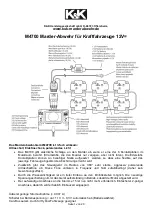
10
Starting Up and General Running Hints
ENGINE RUNNING-IN PERIOD
It is not necessary to drive the new car at consistently low speeds during the first few hundred miles
of operation. Precision manu-facturing methods and improved design make it possible to begin
driving in a normal manner.
While speeds in excess of 50 miles an hour should be avoided for the first 300 miles, occasional
spurts up to this speed (after the engine is warmed) will materially assist the “running-in” process.
After 300 miles of driving, occasional bursts of higher speed are not only permissible but desirable.
The new car should not, however, be operated at top speed until if has been driven at least 500
miles. High speed should always be avoided until the engine is warmed up to operating temperature.
During the “running-in” period it is extremely important to keep close watch on the engine oil level
and the panel instruments—especially the temperature and oil pressure gauges. Sustained high
engine speed should be avoided during early life of the new car so that all parts will become adjusted
to their position without excess friction and heat.
The observance of these precautions will be reflected later on in the prolonged life of the car. Under
this heading, lubrication is by far the most important item. Many troubles are directly traceable to lack
of proper lubrication and owners will be well repaid by giving careful attention to the lubrication diagram.
The engine attains maximum power at 4,600 r.p.m., and 5,200 r.p.m. should not be exceeded.
The illustration on page 6 shows the general arrangement of controls. The following points should
be observed in starting the engine.
STARTING THE ENGINE
It is essential to ensure that the handbrake is applied before starting the engine,
as the
automatic carburetter system will cause the engine to run at a fairly fast idle speed on initial starting
from cold.
On cars with automatic transmission, move the gear range selector lever to neutral, quadrant position
“N”. The engine cannot be started unless the selector lever is in this position.
FOR STARTING FROM COLD
Depress the accelerator pedal slowly to one third of its travel and allow it to return to closed
position before starting the engine.
Turn ignition key to extreme right to operate starter. When engine fires, release key. The engine
should start immediately.
NOTE—Do not pump accelerator pedal. If engine does not start because of excess fuel in
cylinders, push accelerator pedal slowly to full open and operate starter while keeping pedal
depressed.
The fuel mixture is automatically adjusted to provide for easy engine starting and for the warming
up and operating periods.
GEARBOX OPERATION
The automatic gearbox is more than just a mechanism which automatically adjusts the gear ratios
according to conditions of speed and load. An overriding control is provided which enables the driver
to exercise his own judgement and desire in regard to the gear ratios to be selected and an
understanding of what is possible greatly enhances the pleasure to be derived from driving the car.
The gearbox provides three forward speeds, Neutral and Reverse. The control quadrant is marked
as follows :—
RND 2 1
The following indicates the gears obtained in each range :
“1”
1st only (Maximum permissible 48 m.p.h.)
1st and 2nd (Maximum permissible 82 m.p.h.) “D” 1st, 2nd and top
“N” Neutral
“R” Reverse
There is one ‘gate’ position for reverse only.
To change into reverse press the button in the end of the gear lever.
TO DRIVE AWAY
If the driver so desires, he can leave everything to the automatic gearbox and gear changes will occur
at the theoretically correct moment in terms of speed and load. Obviously, however, road or traffic
conditions may be such that the automatic gear change may be undesirable, and it is for this reason
that the overriding controls are provided to enable the driver to enforce a gear change as and when











































